

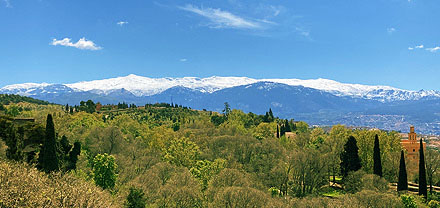
Granada is blessed with the spectacular Sierra Nevada mountains as a backdrop.
There have been settlements in this region of Spain since tribal colonies made it their home in the 5th century BC. Later invading Phoenicians and Carthaginians moved in but by 200BC it was the Romans who ruled here, though Granada was not regarded as particularly important and they withdrew in the 5th century, leaving it to the Visigoths.

In 711 Muslim forces arrived and in only seven years had conquered the Iberian peninsula.
In the thirteenth century, while Seville and Cordoba fell to the encroaching Christian armies, the Nasrid dynasty formed an independent emirate in Granada, paving the way for its growth into an important city. Over the course of 250 years it became rich, financially and also culturally, with influential scientific and artistic endeavours.


It was the last stronghold of the Moors until it was taken by Ferdinand and Isabella in 1492 to complete their Christian reconquest of Spain.
In 2001, having an entrance time to the Alhambra of 4:30, we had plenty of time to wander the city - the nicest part of which is El Albayzin, a Moorish maze of alleyways and small squares.



It is worth the climb to the San Nicolas mirador for the view over the canyon to the Alhambra and the Alcazaba fortress standing high above the city.



The Alhambra was built on the hill of al Sasbika above Granada in the fourteenth century during the rule of the Nasrid Muslim dynasty and is the main, though not the only, reason to visit Granada.


In 1492, after an eight month siege, the Catholics seized the city and the Alhambra. In subsequent years they made many alterations, not least Charles V demolished a wing of palaces to build his hulking Renaissance palace.
The palace complex is composed of the Alcazaba - the original fortress, the Generalife - originally a summer palace for Granada's rulers, and the Palacios Nazaries - Nasrid Palaces, a multitude of buildings and pleasant courtyards in sumptuous Islamic style.

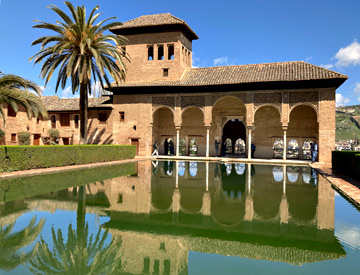
The Palacio del Partal is one of the oldest parts of the Alhambra, dating from the early 14th century. The style of the decoration suggests that it was built during the reign of sultan Muhammad III (1302-1309).1
It has been extensively renovated since its owner, Arthur Von Gwinner, gave it to the state in 1891 when he returned to Germany. At that time the interior walls had been almost completely covered so that the decoration was hidden from view.


It comprises an elegant five-arched portico fronting an airy building with wide views over Granada. The lovely portico is reflected in a large rectangular pool, though the central arch is the only original.

At one end the Torre de las Damas rises to another storey with a mirador above the main building, it has the oldest decoration of the Alhambra.
The building has been much altered by successive inhabitants since the Islamic period. The original wooden dome of the tower is now held in the Pergamon Museum in Berlin.



The Mosque Baths of the Alhambra stand on the route between the palaces and the Generalife.
These typical steam baths, hammam, were often located close to a mosque to provide facilities for ablutions before prayer, as is the case for these.

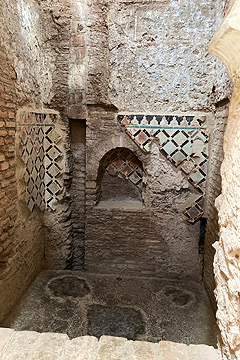

When Mohammed I, the founder of the Nasrid dynasty, moved his court to Granada in 1237 he built this massive fort to protect against the encroaching Christian armies.





The 13th century summer palace of the sultans has beautifully laid out gardens with fountains, flowing channels of water, tall trees for shade and colourful flower beds. Its name comes from the Arabic "jinan al-'arif" which can be translated as "the architect's garden".
Though Nasrid in origin, the Generalife has undergone many changes since it was first created. Original layouts remain in some areas but much of the type of planting is fairly recent and pools and arcades were added in the early twentieth century.




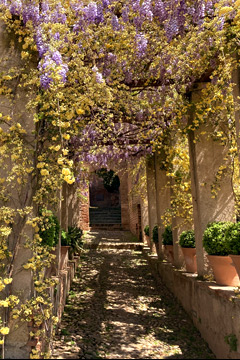
The Generalife originally had fruit and vegetable gardens as well as ornamental gardens, and there are still extensive vegetable plots on the lower slopes of the hill on which it was built, the lowest of several levels of terracing.
The next terrace is occupied by the long, rectangular Jardines Bajos or Lower Gardens, also known as the Jardines Nuevos, the New Gardens, with a long central water channel and fountains, the central one surrounded by four tall cypress trees. These were largely laid out in the twentieth century; there is also an open air theatre at its southern end.




Above the Jardines Bajos is the terrace of the palace with two lovely courtyards: Patio de la Acequia and Patio de la Sultana.
In 1525 Andrea Navagero became the Venetian ambassador to Spain, and remained in Spain until 1528.2 He had a passion for gardens and visited the Alhambra in 1526, waxing lyrical about the Generalife in letters to a friend, Giovanni Battista Ramusio. He provides us with an early description of the gardens before many alterations were made. Thus he describes a space which has "water flowing in a channel, and is full of beautiful myrtles, and orange trees in the middle, in which there is a loggia", the Patio de la Acequia.
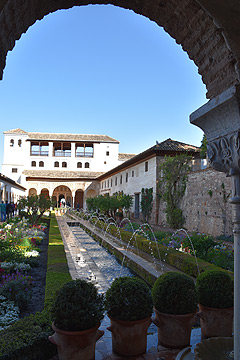



This patio now has many colourful plants either side of the water channel, but its basic layout remains the same.
A pavilion stands at both the north and south ends of the patio.



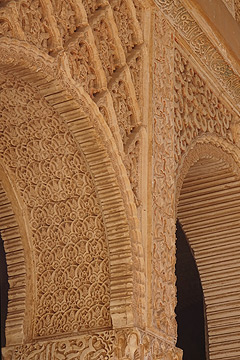





Through the north pavilion, which is decorated with delicate carved stonework, one reaches the Patio de la Sultana.



The Patio de la Sultana is a cool courtyard with as much water as plants and several fountains. Planting is predominantly green creating a harmonious, very soothing space.
Against the east wall a tiled plaque describes the legend of the Sultana who was discovered here by her husband with her lover, a noble knight of the Abencerraje family. The trunk of the reputedly 700-year-old cyprus which shaded them still stands.


From the next terrace above the Patio de la Sultana a set of steps rises steeply up the hillside. These are the Escalera del Agua - the water stairs. This 14th century staircase leads to the highest level of the Generalife.
Water flows down deep channels on either side of the staircase and there is a series of three landings on the staircase, each with a fountain and channels to direct water down the stairs.
 The Mirador Romantico above the walls of the Generalife Palace.
The Mirador Romantico above the walls of the Generalife Palace.

Navagero was enchanted by the abundant use of water in the gardens, and particularly by this staircase where, he said, "if they want to increase the amount of water, they increase it so much that it does not go in its place, it overflows, and floods all the levels, and bathes everyone it finds, making a thousand jokes of this sort."2
Nearby is the 19th century Mirador Romantico standing at the highest point of the Generalife.
We continued our visit in the magnificent Nasrid Palaces.
